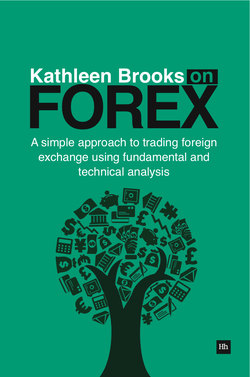Читать книгу Kathleen Brooks on Forex - Kathleen Brooks - Страница 6
На сайте Литреса книга снята с продажи.
Introduction
ОглавлениеIt was 2006 and I had just joined the forex trading desk at BP as a junior trading analyst. I was a novice, in fact extremely novice, probably the least experienced person that had ever walked on to the BP trading floor. Hence I was not only a young female on a desk full of men but I didn’t even have a finance or economics degree. In sum I was totally clueless.
The patience of the traders, the chief dealer and my direct boss, the head of the analytics desk, was amazing. They got me up to scratch on bids and offers, what a pip was and how to trade. They also taught me how fundamentals impact the market. The crossover between central banks, economic data and even politics gripped my imagination and has determined my career path ever since.
In spite of this valuable tuition, when I started out there were a few things I just couldn’t understand. Firstly, why was the dollar in such a steep decline? It had been heading south for years against the pound, the yen and the euro. I didn’t understand why the dollar would always falter – what about the mean-reversion and efficient markets I had spent months learning about? Also, why did the dollar always seem to fall on good economic news out of the US?
If the currency was a reflection of the state of the economy then the US must be in deep economic trouble. But back then growth in America was quite strong and the financial crisis was still ahead of us.
Hence I would write long treatises about how oversold the dollar was, but I could never make a winning trade. I grasped economics and the markets fairly quickly, but something wasn’t right. The dollar continued to go against me and I wanted to know why. That was when I learned a bit more theory about the importance of central banks, relative interest rate strategies, changing global growth dynamics and the concept of the safe haven.
As intelligent as I thought all of this new knowledge made me sound, I quickly realised that every time I thought the signals pointed to a stronger dollar, it weakened, and vice versa. Was this market nuts, or should I just give up the challenge of trying to teach myself something I knew nothing about and go and work in something more suited to my academic background?
Luckily I stuck with it and after some time I started to grasp that although you could be fundamentally right, you could be technically wrong. That was when it clicked; you need to use technical analysis too.
Back to my desk at BP, the guy I sat next to was always trying to show off his technical analysis skills and used fancy words that he knew would confuse me. I kept looking over his shoulder and eventually picked up a few terms the technicians like to throw about: support, resistance, MACD (and no, it’s not a burger), RSI and Fibonacci. This last point solidified my affection for the FX market. Fibonacci numbers may have been discovered by man but they are derived from nature and this resonated with me. There is a magical, almost mystical, side to how financial markets move, hence price movements tend to follow patterns in nature, and that was a major comfort to me.
Try as I might though, I could only get interested in a few of the elements of technical analysis. Too many lines on the chart, with bull and bear flags popping up every few minutes, left me blurry eyed. While I started to appreciate the benefits of technical analysis I needed something more. That was when it came to me – you can’t trade just on the fundamentals or the technicals, you need to fuse them. It seemed to me that the medium-term direction of a cross was down to the fundamentals but the day-to-day price moves, or intra-daily price moves, were all down to technicals.
I decided to stop trying to do what I thought I should do and start doing what I enjoy. I decided to concentrate on the fundamentals and combine them with my favourite technical indicators. That was a match made in heaven for me. That’s not to say that I became the most profitable trader in the world, but instead I started to enjoy what I was doing and felt more in control. Hence the birth of my forex philosophy.
After a spell away from foreign exchange and back at graduate school (still not economics, instead journalism) I re-entered the retail FX market a few years back. This has given me the chance to further refine my forex trading approach, which is what I will share with you.
Thank you for reading.
Kathleen Brooks, London, 2013
